Yuxi Liu
Once-for-All: Controllable Generative Image Compression with Dynamic Granularity Adaption
Jun 02, 2024



Abstract:Although recent generative image compression methods have demonstrated impressive potential in optimizing the rate-distortion-perception trade-off, they still face the critical challenge of flexible rate adaption to diverse compression necessities and scenarios. To overcome this challenge, this paper proposes a Controllable Generative Image Compression framework, Control-GIC, the first capable of fine-grained bitrate adaption across a broad spectrum while ensuring high-fidelity and generality compression. We base Control-GIC on a VQGAN framework representing an image as a sequence of variable-length codes (i.e. VQ-indices), which can be losslessly compressed and exhibits a direct positive correlation with the bitrates. Therefore, drawing inspiration from the classical coding principle, we naturally correlate the information density of local image patches with their granular representations, to achieve dynamic adjustment of the code quantity following different granularity decisions. This implies we can flexibly determine a proper allocation of granularity for the patches to acquire desirable compression rates. We further develop a probabilistic conditional decoder that can trace back to historic encoded multi-granularity representations according to transmitted codes, and then reconstruct hierarchical granular features in the formalization of conditional probability, enabling more informative aggregation to improve reconstruction realism. Our experiments show that Control-GIC allows highly flexible and controllable bitrate adaption and even once compression on an entire dataset to fulfill constrained bitrate conditions. Experimental results demonstrate its superior performance over recent state-of-the-art methods.
SelfGNN: Self-Supervised Graph Neural Networks for Sequential Recommendation
May 31, 2024



Abstract:Sequential recommendation effectively addresses information overload by modeling users' temporal and sequential interaction patterns. To overcome the limitations of supervision signals, recent approaches have adopted self-supervised learning techniques in recommender systems. However, there are still two critical challenges that remain unsolved. Firstly, existing sequential models primarily focus on long-term modeling of individual interaction sequences, overlooking the valuable short-term collaborative relationships among the behaviors of different users. Secondly, real-world data often contain noise, particularly in users' short-term behaviors, which can arise from temporary intents or misclicks. Such noise negatively impacts the accuracy of both graph and sequence models, further complicating the modeling process. To address these challenges, we propose a novel framework called Self-Supervised Graph Neural Network (SelfGNN) for sequential recommendation. The SelfGNN framework encodes short-term graphs based on time intervals and utilizes Graph Neural Networks (GNNs) to learn short-term collaborative relationships. It captures long-term user and item representations at multiple granularity levels through interval fusion and dynamic behavior modeling. Importantly, our personalized self-augmented learning structure enhances model robustness by mitigating noise in short-term graphs based on long-term user interests and personal stability. Extensive experiments conducted on four real-world datasets demonstrate that SelfGNN outperforms various state-of-the-art baselines. Our model implementation codes are available at https://github.com/HKUDS/SelfGNN.
FedFMS: Exploring Federated Foundation Models for Medical Image Segmentation
Mar 08, 2024Abstract:Medical image segmentation is crucial for clinical diagnosis. The Segmentation Anything Model (SAM) serves as a powerful foundation model for visual segmentation and can be adapted for medical image segmentation. However, medical imaging data typically contain privacy-sensitive information, making it challenging to train foundation models with centralized storage and sharing. To date, there are few foundation models tailored for medical image deployment within the federated learning framework, and the segmentation performance, as well as the efficiency of communication and training, remain unexplored. In response to these issues, we developed Federated Foundation models for Medical image Segmentation (FedFMS), which includes the Federated SAM (FedSAM) and a communication and training-efficient Federated SAM with Medical SAM Adapter (FedMSA). Comprehensive experiments on diverse datasets are conducted to investigate the performance disparities between centralized training and federated learning across various configurations of FedFMS. The experiments revealed that FedFMS could achieve performance comparable to models trained via centralized training methods while maintaining privacy. Furthermore, FedMSA demonstrated the potential to enhance communication and training efficiency. Our model implementation codes are available at https://github.com/LIU-YUXI/FedFMS.
Region-Adaptive Transform with Segmentation Prior for Image Compression
Mar 01, 2024



Abstract:Learned Image Compression (LIC) has shown remarkable progress in recent years. Existing works commonly employ CNN-based or self-attention-based modules as transform methods for compression. However, there is no prior research on neural transform that focuses on specific regions. In response, we introduce the class-agnostic segmentation masks (i.e. semantic masks without category labels) for extracting region-adaptive contextual information. Our proposed module, Region-Adaptive Transform, applies adaptive convolutions on different regions guided by the masks. Additionally, we introduce a plug-and-play module named Scale Affine Layer to incorporate rich contexts from various regions. While there have been prior image compression efforts that involve segmentation masks as additional intermediate inputs, our approach differs significantly from them. Our advantages lie in that, to avoid extra bitrate overhead, we treat these masks as privilege information, which is accessible during the model training stage but not required during the inference phase. To the best of our knowledge, we are the first to employ class-agnostic masks as privilege information and achieve superior performance in pixel-fidelity metrics, such as Peak Signal to Noise Ratio (PSNR). The experimental results demonstrate our improvement compared to previously well-performing methods, with about 8.2% bitrate saving compared to VTM-17.0. The code will be released at https://github.com/GityuxiLiu/Region-Adaptive-Transform-with-Segmentation-Prior-for-Image-Compression.
Hypergraph Convolutional Networks for Fine-grained ICU Patient Similarity Analysis and Risk Prediction
Aug 24, 2023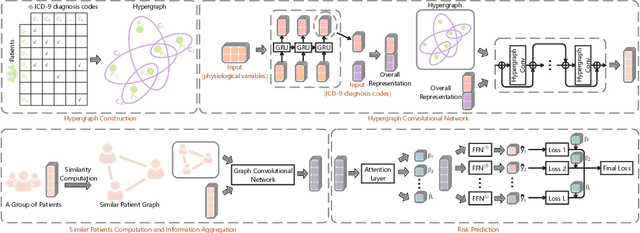
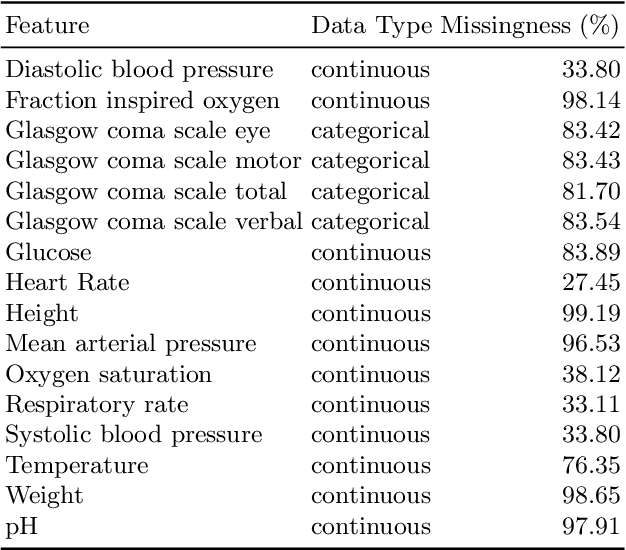
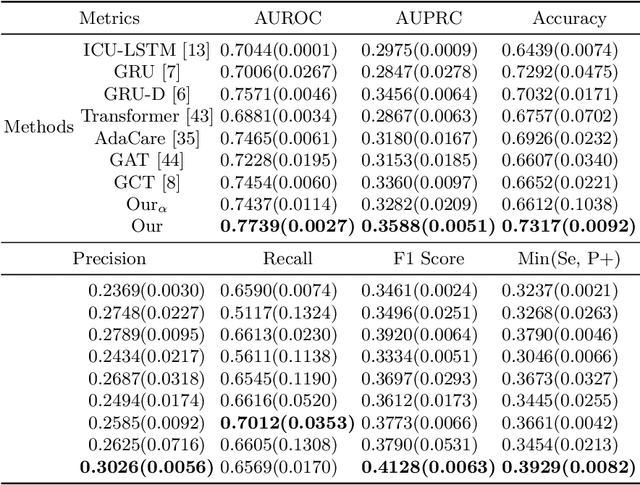

Abstract:The Intensive Care Unit (ICU) is one of the most important parts of a hospital, which admits critically ill patients and provides continuous monitoring and treatment. Various patient outcome prediction methods have been attempted to assist healthcare professionals in clinical decision-making. Existing methods focus on measuring the similarity between patients using deep neural networks to capture the hidden feature structures. However, the higher-order relationships are ignored, such as patient characteristics (e.g., diagnosis codes) and their causal effects on downstream clinical predictions. In this paper, we propose a novel Hypergraph Convolutional Network that allows the representation of non-pairwise relationships among diagnosis codes in a hypergraph to capture the hidden feature structures so that fine-grained patient similarity can be calculated for personalized mortality risk prediction. Evaluation using a publicly available eICU Collaborative Research Database indicates that our method achieves superior performance over the state-of-the-art models on mortality risk prediction. Moreover, the results of several case studies demonstrated the effectiveness of constructing graph networks in providing good transparency and robustness in decision-making.
Contrastive Learning-based Imputation-Prediction Networks for In-hospital Mortality Risk Modeling using EHRs
Aug 19, 2023Abstract:Predicting the risk of in-hospital mortality from electronic health records (EHRs) has received considerable attention. Such predictions will provide early warning of a patient's health condition to healthcare professionals so that timely interventions can be taken. This prediction task is challenging since EHR data are intrinsically irregular, with not only many missing values but also varying time intervals between medical records. Existing approaches focus on exploiting the variable correlations in patient medical records to impute missing values and establishing time-decay mechanisms to deal with such irregularity. This paper presents a novel contrastive learning-based imputation-prediction network for predicting in-hospital mortality risks using EHR data. Our approach introduces graph analysis-based patient stratification modeling in the imputation process to group similar patients. This allows information of similar patients only to be used, in addition to personal contextual information, for missing value imputation. Moreover, our approach can integrate contrastive learning into the proposed network architecture to enhance patient representation learning and predictive performance on the classification task. Experiments on two real-world EHR datasets show that our approach outperforms the state-of-the-art approaches in both imputation and prediction tasks.
Integrated Convolutional and Recurrent Neural Networks for Health Risk Prediction using Patient Journey Data with Many Missing Values
Nov 14, 2022Abstract:Predicting the health risks of patients using Electronic Health Records (EHR) has attracted considerable attention in recent years, especially with the development of deep learning techniques. Health risk refers to the probability of the occurrence of a specific health outcome for a specific patient. The predicted risks can be used to support decision-making by healthcare professionals. EHRs are structured patient journey data. Each patient journey contains a chronological set of clinical events, and within each clinical event, there is a set of clinical/medical activities. Due to variations of patient conditions and treatment needs, EHR patient journey data has an inherently high degree of missingness that contains important information affecting relationships among variables, including time. Existing deep learning-based models generate imputed values for missing values when learning the relationships. However, imputed data in EHR patient journey data may distort the clinical meaning of the original EHR patient journey data, resulting in classification bias. This paper proposes a novel end-to-end approach to modeling EHR patient journey data with Integrated Convolutional and Recurrent Neural Networks. Our model can capture both long- and short-term temporal patterns within each patient journey and effectively handle the high degree of missingness in EHR data without any imputation data generation. Extensive experimental results using the proposed model on two real-world datasets demonstrate robust performance as well as superior prediction accuracy compared to existing state-of-the-art imputation-based prediction methods.
Compound Density Networks for Risk Prediction using Electronic Health Records
Aug 16, 2022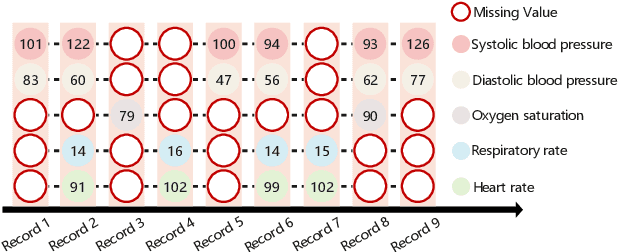
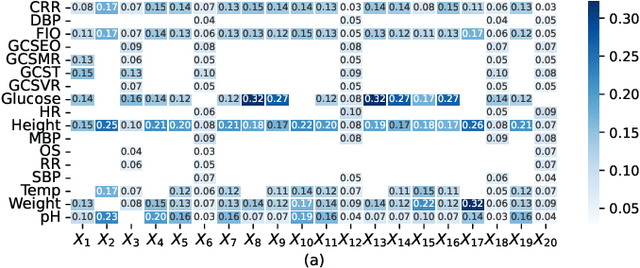
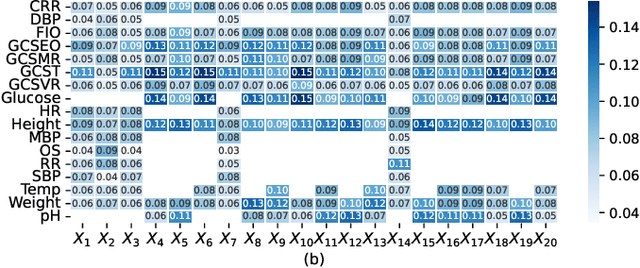

Abstract:Electronic Health Records (EHRs) exhibit a high amount of missing data due to variations of patient conditions and treatment needs. Imputation of missing values has been considered an effective approach to deal with this challenge. Existing work separates imputation method and prediction model as two independent parts of an EHR-based machine learning system. We propose an integrated end-to-end approach by utilizing a Compound Density Network (CDNet) that allows the imputation method and prediction model to be tuned together within a single framework. CDNet consists of a Gated recurrent unit (GRU), a Mixture Density Network (MDN), and a Regularized Attention Network (RAN). The GRU is used as a latent variable model to model EHR data. The MDN is designed to sample latent variables generated by GRU. The RAN serves as a regularizer for less reliable imputed values. The architecture of CDNet enables GRU and MDN to iteratively leverage the output of each other to impute missing values, leading to a more accurate and robust prediction. We validate CDNet on the mortality prediction task on the MIMIC-III dataset. Our model outperforms state-of-the-art models by significant margins. We also empirically show that regularizing imputed values is a key factor for superior prediction performance. Analysis of prediction uncertainty shows that our model can capture both aleatoric and epistemic uncertainties, which offers model users a better understanding of the model results.
Modeling Long-term Dependencies and Short-term Correlations in Patient Journey Data with Temporal Attention Networks for Health Prediction
Jul 15, 2022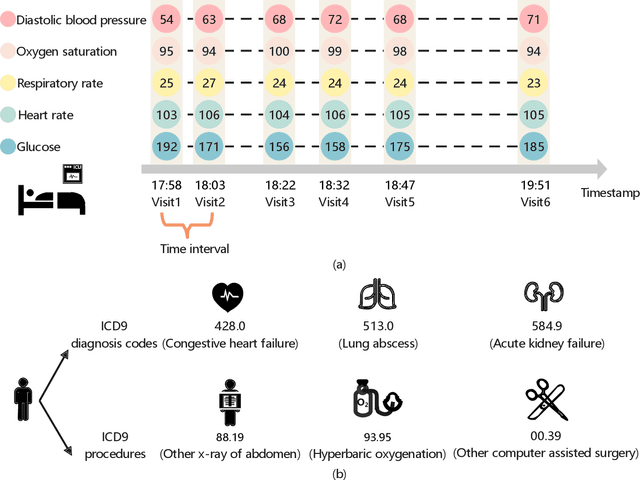

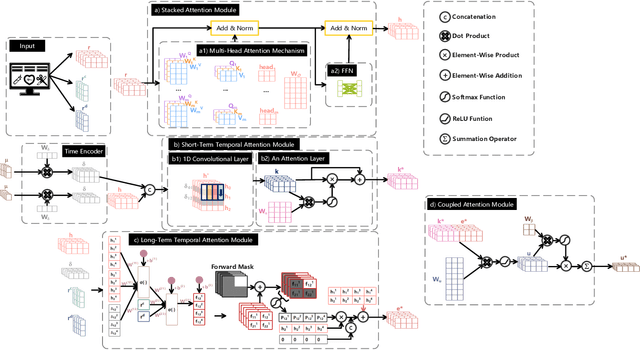

Abstract:Building models for health prediction based on Electronic Health Records (EHR) has become an active research area. EHR patient journey data consists of patient time-ordered clinical events/visits from patients. Most existing studies focus on modeling long-term dependencies between visits, without explicitly taking short-term correlations between consecutive visits into account, where irregular time intervals, incorporated as auxiliary information, are fed into health prediction models to capture latent progressive patterns of patient journeys. We present a novel deep neural network with four modules to take into account the contributions of various variables for health prediction: i) the Stacked Attention module strengthens the deep semantics in clinical events within each patient journey and generates visit embeddings, ii) the Short-Term Temporal Attention module models short-term correlations between consecutive visit embeddings while capturing the impact of time intervals within those visit embeddings, iii) the Long-Term Temporal Attention module models long-term dependencies between visit embeddings while capturing the impact of time intervals within those visit embeddings, iv) and finally, the Coupled Attention module adaptively aggregates the outputs of Short-Term Temporal Attention and Long-Term Temporal Attention modules to make health predictions. Experimental results on MIMIC-III demonstrate superior predictive accuracy of our model compared to existing state-of-the-art methods, as well as the interpretability and robustness of this approach. Furthermore, we found that modeling short-term correlations contributes to local priors generation, leading to improved predictive modeling of patient journeys.
Single Shot Reversible GAN for BCG artifact removal in simultaneous EEG-fMRI
Nov 04, 2020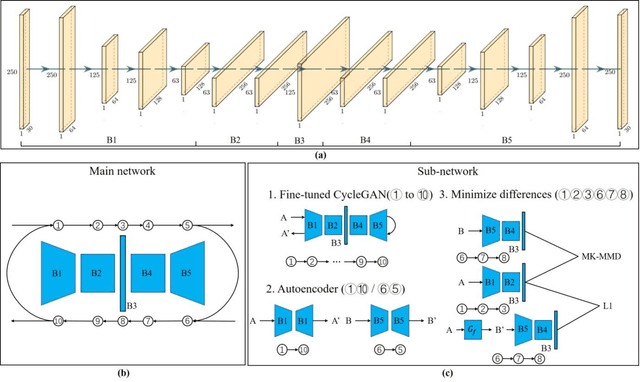



Abstract:Simultaneous EEG-fMRI acquisition and analysis technology has been widely used in various research fields of brain science. However, how to remove the ballistocardiogram (BCG) artifacts in this scenario remains a huge challenge. Because it is impossible to obtain clean and BCG-contaminated EEG signals at the same time, BCG artifact removal is a typical unpaired signal-to-signal problem. To solve this problem, this paper proposed a new GAN training model - Single Shot Reversible GAN (SSRGAN). The model is allowing bidirectional input to better combine the characteristics of the two types of signals, instead of using two independent models for bidirectional conversion as in the past. Furthermore, the model is decomposed into multiple independent convolutional blocks with specific functions. Through additional training of the blocks, the local representation ability of the model is improved, thereby improving the overall model performance. Experimental results show that, compared with existing methods, the method proposed in this paper can remove BCG artifacts more effectively and retain the useful EEG information.
 Add to Chrome
Add to Chrome Add to Firefox
Add to Firefox Add to Edge
Add to Edge